In this nursing pharmacology guide for student nurses, learn about bronchodilators or antiasthmatics, its uses, and the nursing considerations for patients using them.
Bronchodilators or antiasthmatics are medications used to facilitate respiration by dilating the airways. They are helpful in symptomatic relief or prevention of bronchial asthma and for bronchospasm associated with COPD.
Table of Contents
- Bronchodilators and Antiasthmatics: Generic and Brand Names
- Disease spotlight: Bronchial Asthma
- Xanthines
- Sympathomimetics
- Anticholinergics
- Nursing Considerations for Bronchodilators
- Recommended Resources
- See Also
- References and Sources
Bronchodilators and Antiasthmatics: Generic and Brand Names
Here are some of the most commonly encountered bronchodilators or antiasthmatics, their generic names, and brand names.
- Xanthines
- aminophylline (Truphylline)
- caffeine
- dyphylline (Dilor)
- theophylline (Slo-Bid, Theo-Dur)
- Sympathomimetics
- Anticholinergics
- ipratropium (Atrovent)
- tiotropium (Sprival)
Disease spotlight: Bronchial Asthma
Asthma is characterized by reversible bronchospasm, inflammation, and hyperactive airways.
- The hyperactivity is triggered by allergens or nonallergic inhaled irritants, or by factors such as exercise and emotions.
- The trigger causes an immediate release of histamine, which results in bronchospasm in about 10 minutes.
- The later response (3-5 hours) is cytokine-mediated inflammation, mucus production, and edema contributing to obstruction.
- Appropriate treatment depends on understanding the early and late responses.
- The extreme case of asthma is called status asthmaticus; this is life-threatening bronchospasm that does not respond to usual treatment and occludes airflow into the lungs.
Xanthines
The xanthines come from a variety of naturally occurring sources. These drugs were once the main treatment choices for asthma and bronchospasm. However, because they have a relatively narrow margin of safety and interact with many other drugs, they are no longer considered the first-choice bronchodilators.
Therapeutic actions of Xanthines
The desired actions of xanthines include:
- A direct effect on the smooth muscles of the respiratory tract, both in the bronchi and in the blood vessels.
- A theory suggests that xanthines work by directly affecting the mobilization of calcium within the cell.
- They do this by stimulating two prostaglandins, resulting in smooth muscle relaxation, which increases the vital capacity that has been impaired by the bronchospasm or air trapping.
- Xanthines also inhibit the release of slow-reacting substance of anaphylaxis and histamine, decreasing the bronchial swelling and narrowing that occurs as a result of these two chemicals.
Indications
Xanthines are indicated for the following:
- Relief of symptoms or prevention of bronchial asthma.
- Reversal of bronchospasm associated with COPD.
Pharmacokinetics
The xanthines are rapidly absorbed from the GI tract when given orally
| Route | Onset | Peak | Duration |
| Oral | 1-6 h | 4-6 h | 6-8 h |
| IV | Immediate | 30 min | 4-8 h |
| T 1/2: 3 to 15 hours (nonsmoker), 4 to 5 hours (smoker) | |||
| Metabolization: Liver | |||
| Excretion: Urine |
Contraindications and Cautions
The following are contraindications and cautions when using xanthines:
- Co-morbidities. Caution should be taken with any patient with GI problems, coronary disease, respiratory dysfunction, renal or hepatic disease, alcoholism, or hyperthyroidism because these conditions can be exacerbated by the systemic effects of xanthines.
- Long-term parenteral use. Xanthines are available for oral and parenteral use; the parenteral drug should be switched to oral form as soon as possible because the systemic effects of the oral form are less acute and more manageable.
- Pregnancy. Although no studies are available of xanthine effects on human pregnancy, they have been associated with fetal abnormalities and breathing difficulties at birth in animal studies, so use should be limited to situations in which the benefit to the mother clearly outweighs the potential risk to the fetus.
- Lactation. Because the xanthines enter breastmilk and could affect the baby, another method of feeding the baby should be selected if these drugs are needed during lactation.
Adverse Effects
Adverse effects from the use of xanthines include the following:
- CNS: Irritability, restlessness, dizziness.
- Cardiovascular: Palpitations, life-threatening arrhythmias.
- Others: Loss of appetite, fever, flushing.
- GU: Proteinuria.
- Respiratory: Respiratory arrest.
Interactions
Because of the mechanism of xanthine metabolism in the liver, many drugs interact with xanthines.
- Nicotine. Nicotine increases the metabolism of xanthines in the liver; xanthine dose must be increased in patients who continue to smoke while using xanthines.
Sympathomimetics
- Sympathomimetics are drugs that mimic the effects of the sympathetic nervous system.
- One of the actions of the sympathetic nervous system is dilation of the bronchi with increased rate and depth of respiration.
- This is the desired effect when selecting a sympathomimetic as a bronchodilator.
Therapeutic Actions
The desired actions of sympathomimetics include the following:
- At therapeutic levels, the action of most sympathomimetics are specific to the beta-receptors found in the bronchi.
- Other systemic effects include increased blood pressure, increased heart rate, vasoconstriction, and decreased renal and GI blood flow- all actions of the sympathetic nervous system.
- Epinephrine, the prototype drug, is the drug of choice for adults and children for the treatment of acute bronchospasm, including that caused by anaphylaxis; it is also available for inhalation.
Indications
Sympathomimetics are indicated for the following:
- Long-acting treatment and prophylaxis of bronchospasm and prevention of exercise-induced bronchospasm in patients 2 years and older.
- Long-term maintenance treatment of bronchoconstriction in COPD.
- Treatment of acute bronchospasm in adults and children, although epinephrine is the drug of choice.
- Treatment and prophylaxis of acute asthma attacks in children more than 6 years old.
Pharmacokinetics
Sympathomimetics are absorbed in many ways:
| Route | Onset | Peak | Duration |
| SC | 5-10 min | 20 min | 20-30 min |
| IM | 5-10 min | 20 min | 20-30 min |
| IV | Instant | 20 min | 20-30 min |
| Inhalation | 3-5 min | 20 min | 1-3 h |
| T 1/2: Unknown | |||
| Metabolization: Normal neural pathways |
Contraindications and Cautions
The following are contraindications and cautions when using sympathomimetics:
- Underlying conditions. These drugs are contraindicated or should be used with caution, depending on the severity of the underlying condition, in conditions that would be aggravated by the sympathetic stimulation, including cardiac disease, vascular disease, arrhythmias, diabetes, and hyperthyroidism.
- Pregnancy and lactation. These drugs should be used during pregnancy and lactation only if the benefits to the mother clearly outweigh potential risks to the fetus or neonate.
Adverse Effects
Adverse effects when using sympathomimetics include the following:
- CNS: Headache, restlessness.
- Cardiovascular: Palpitation, tachycardia.
- Skin: Pallor, local burning and stinging.
- GU: Decreased renal formation.
- Respiratory: Rebound congestion with nasal inhalation.
- Misc: Fear, anxiety.
Interactions
Special precautions should be taken to avoid the combination of sympathomimetic bronchodilators with the general anesthetics.
- Cyclopropane and halogenated hydrocarbons. Because these drugs sensitize the myocardium to catecholamines, serious cardiac complications could occur.
Anticholinergics
- Patients who cannot tolerate the sympathetic effects of sympathomimetics might respond to the anticholinergic drugs ipratropium (Atrovent) and tiotropium (Spiriva).
- These drugs are not as effective as the sympathomimetics but can provide some relief to those patients who cannot tolerate the other drugs.
Therapeutic actions
The desired effects of anticholinergics include:
- Anticholinergics are used as bronchodilators because of their effect on the vagus nerve, which sis to block or antagonize the action of the neurotransmitter acetylcholine at vagal-mediated receptor sites.
- By blocking the vagal effect, relaxation of smooth muscle in the bronchi occurs, leading to bronchodilation.
Indications
Anticholinergics are indicated for the following:
- Maintenance and treatment of bronchospasm for adults with COPD.
- Long-term, once-daily maintenance and treatment of bronchospasm associated with COPD in adults.
Pharmacokinetics
Anticholinergics are available for inhalation, using an inhaler device.
| Route | Onset | Peak | Duration |
| Inhalation | 15 min | 1-2 h | 3-4 h |
| T 1/2: Unknown | |||
| Metabolization: Neural pathways |
Contraindications
The following are contraindications and cautions when using anticholinergics:
- Co-morbidities. Caution should be used in any condition that would be aggravated by the anticholinergic or atropine-like effects of the drug, such as narrow-angle glaucoma, bladder neck obstruction or prostatic hypertrophy, and conditions aggravated by dry mouth and throat.
- Allergy. The use of ipratropium or tiotropium is contraindicated in the presence of known allergy to the drug or to soy products or peanuts to prevent hypersensitivity reactions.
- Pregnancy and lactation. These drugs are not usually absorbed systematically, but as with all the drugs, caution should be used in pregnancy and lactation because of the potential for adverse effects on the fetus or nursing baby.
Adverse effects
Adverse effects when using anticholinergics include the following:
- CNS: Dizziness, headache.
- GI: Nausea, gastrointestinal distress.
- Cardiovascular: Palpitations.
- Respiratory: Cough.
- Misc: Nervousness.
Nursing Considerations for Bronchodilators
Nursing considerations for patients taking bronchodilators or antiasthmatics include the following:
Nursing Assessment
History taking and physical examination of patients taking bronchodilators or antiasthmatics.
- Assess for possible contraindications or cautions: any known allergies to prevent hypersensitivity reactions; cigarette use which affects the metabolism of the drug; peptic ulcer, gastritis, renal or hepatic dysfunction, and coronary disease, all of which could be exacerbated and require cautious use; and pregnancy and lactation, which are contraindications because of the potential for adverse effects on the fetus or nursing baby.
- Perform a physical examination to establish baseline data for assessing the effectiveness of the drug and the occurrence of any adverse effects associated with drug therapy.
- Perform a skin examination, including color and the presence of lesions, to provide a baseline as a reference for drug effectiveness.
- Monitor blood pressure, pulse, cardiac auscultation, peripheral perfusion, and baseline electrocardiogram to provide a baseline for effects on the cardiovascular system.
- Assess bowel sounds and do a liver evaluation and monitor liver and renal function tests to provide a baseline for renal and hepatic function tests.
- Evaluate serum theophylline levels to provide a baseline reference and identify conditions that may require caution in the use of xanthines.
- Evaluate urinary output and prostate palpation as appropriate to monitor anticholinergic effects.
- Evaluate orientation, affect, and reflexes to evaluate CNS effects.
Nursing Diagnosis and Care Planning
Nursing diagnosis and care planning related to drug therapy include:
- Acute pain related to headache and GI upset.
- Disturbed sensory perception (kinesthetic, visual) related to CNS effects.
- Deficient knowledge regarding drug therapy.
- Increased cardiac output related to sympathomimetic effects.
- Disturbed thought processes related to CNS effects.
- Imbalanced nutrition: less than body requirements related to dry mouth and GI upset.
Nursing Implementation with Rationale
The nursing interventions for patients using bronchodilators or antiasthmatics include:
- Relieve GI upset. Administer oral drug with food or milk to relieve GI irritation if GI upset is a problem.
- Monitor drug response. Monitor patient response to the drug (e.g., relief of respiratory difficulty, improved airflow) to determine the effectiveness of the drug dose and to adjust dose as needed.
- Provide comfort. Provide comfort measures including rest periods, quiet environment, dietary control of caffeine, and headache therapy as needed, to help the patient cope with the effects of drug therapy.
- Provide follow-ups. Provide periodic follow-up, including blood tests, to monitor serum theophylline levels.
- Individual drug response. Reassure patient that the drug of choice will vary with each individual; these sympathomimetics are slightly different chemicals and are prepared in a variety of delivery systems; a patient may have to try several different sympathomimetics before the most effective one is found.
- Proper administration and dosage. Advise the patient to use the minimal amount needed for the shortest period necessary to prevent adverse effects and accumulation of drug levels.
- Proper use of sympathomimetics. Teach the patients who use one of these drugs for exercise-induced asthma to use it 30 to 60 minutes before exercising to ensure peak therapeutic effects when they are needed.
- Use of adrenergic blockers. Alert the patient that long-acting adrenergic blockers are not for use during acute attacks because they are slower acting and will not provide the necessary rescue in a state of acute bronchospasm.
- Increase oral fluid intake. Ensure adequate hydration and provide environmental controls such as the use of a humidifier, to make the patient more comfortable.
- Encourage voiding. Encourage the patient to void before each dose of medication to avoid urinary retention related to drug effects.
- Small, frequent meals. Provide small, frequent meals and sugarless lozenges to relieve dry mouth and GI upset.
- Use of inhalator. Review the use of inhalator with the patient; caution the patient not to exceed 12 inhalations in 24 hours to prevent serious adverse effects.
- Educate the patient. Provide thorough patient teaching, including the drug name and prescribed dosage measures to help avoid adverse effects, warning signs that may indicate problems, and the need for periodic monitoring and evaluation, to enhance patient knowledge about drug therapy and to promote compliance.
- Provide patient support. Offer support and encouragement to help the patient cope with the disease and the drug regimen.
Evaluation
Evaluation of a patient using bronchodilators/antiasthmatics include the following:
- Monitor patient response to the drug (improved airflow, ease of respirations, improved breathing).
- Monitor for adverse effects (CNS effects, increased pulse or blood pressure, GI upset, dry skin, and mucous membranes).
- Evaluate the effectiveness of the teaching plan (patient can name drug, dosage, adverse effects to watch for, specific measures to avoid them, and measures to take to increase the effectiveness of the drug).
- Monitor the effectiveness of other measures to ease breathing.
Practice Quiz: Bronchodilators/Antiasthmatics
Here’s a 5-item quiz for this bronchodilator/antiasthmatic study guide. Please visit our nursing test bank page for more NCLEX practice questions.
1. Beta-adrenergic agonists such as albuterol are given to Carlo, a child with asthma. Such drugs are administered primarily to do which of the following?
A. Reduce airway inflammation
B. Decrease postnasal drip
C. Reduce secondary infections
D. Dilate the bronchioles
1. Answer: D. Dilate the bronchioles
- Option D: Beta-adrenergic agonists, such as albuterol, are highly effective bronchodilators and are used to dilate the narrow airways associated with asthma.
- Option A: Corticosteroids may be used for their anti-inflammatory effect.
- Option B: Decongestants may be given to decrease postnasal drip.
- Option C: Antibiotics are used to prevent secondary infection.
2. Maria is rushed to the emergency department during an acute, severe prolonged asthma attack and is unresponsive to usual treatment. The condition is referred to as which of the following?
A. Intrinsic asthma
B. Extrinsic asthma
C. Status asthmaticus
D. Reactive airway disease
2. Answer: C. Status asthmaticus
- Option C: Status asthmaticus is an acute, prolonged, severe asthma attack that is unresponsive to usual treatment. Typically, the child requires hospitalization.
- Option A: Intrinsic is a term used to denote internal precipitating factors, such as viruses.
- Option B: Extrinsic is a term used to denote external precipitating factors, such as allergens.
- Option D: Reactive airway disease is another general term for asthma
3. A client is receiving theophylline intravenously. After several dosages, the client started to become restless and complains of palpitations. The nurse determines that the client is experiencing theophylline toxicity in which of the following?
A. Theophylline level of 2.5 mcg/ml
B. Theophylline level of 5 mcg/ml
C. Theophylline level of 20mcg/ml
D. Theophylline level of 25mcg/ml
3. Answer: D. Theophylline level of 25mcg/ml
- Option D: Theophylline toxicity is likely to occur when the serum level is higher than 20 mcg/ml. Early signs of toxicity include restlessness, nervousness, tachycardia, tremors, and palpitations.
4. The nurse is giving medication teachings to a client receiving theophylline. The nurse instructs the client to limit the intake of which of the following?
A. Strawberries and avocado
B. Butter and cheese
C. Salmon and tuna
D. Hot tea and cocoa
4. Answer: D. Hot tea and cocoa
- Option D: Theophylline is a methylxanthine bronchodilator. The nurse instructs the client to limit the intake of xanthine-containing foods such as chocolate, cola, cocoa, tea, and coffee.
5. When administering the methylxanthine theophylline, the nurse can expect:
A. Decreased pulmonary function
B. Decreased tidal volume
C. Increased pulmonary function
B. Increased residual volume
5. Answer: C. Increased pulmonary function.
- Option C: Theophylline will improve ventilation so there will be an overall improvement of pulmonary measurements.
- Options A, B, D: Other choices are the opposite of what will actually occur with theophylline administration.
Recommended Resources
Our recommended nursing pharmacology resources and books:
Disclosure: Included below are affiliate links from Amazon at no additional cost from you. We may earn a small commission from your purchase which will help support us. Thank you! For more information, check out our privacy policy.
Pharm Phlash! Pharmacology Flash Cards #1 BEST SELLER!
Test-yourself review cards put critical clinical information for nearly 400 of the top generic medications at your fingertips. And, you can count on them for accuracy, because each card is based on content from Davis’s Drug Guide for Nurses. Increase your test scores in pharmacology class.
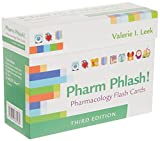
Focus on Pharmacology (8th Edition)
Focus on Nursing Pharmacology makes challenging concepts more approachable. Engaging learning features cultivate your clinical application, critical thinking and patient education capabilities. This updated 8th edition builds on your knowledge of physiology, chemistry and nursing fundamentals to help you conceptualize need-to-know information about each group of drugs.
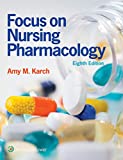
Pharmacology Made Incredibly Easy (Incredibly Easy! Series®)
Nursing pharmacology guide offers step-by-step guidance so you can grasp the fundamentals in enjoyable Incredibly Easy style. This is the perfect supplement to class materials, offering solid preparation for NCLEX® as well as a handy refresher for experienced nurses. Colorfully illustrated chapters offer clear, concise descriptions of crucial nursing pharmacology concepts and procedures.
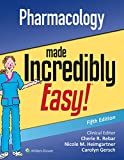
Lehne’s Pharmacology for Nursing Care (11th Edition)
The Eleventh Edition of Lehne’s Pharmacology for Nursing Care provides a thorough understanding of key drugs and their implications for nursing care. This text, written by renowned nursing educators, helps you comprehend and apply pharmacology principles. A clear and engaging writing style simplifies complex concepts, making even the most challenging pharmacology content enjoyable. We recommend this book if you want a comprehensive nursing pharmacology guide.
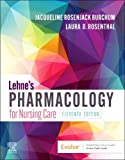
Nursing Drug Handbook
Nursing2023 Drug Handbook delivers evidence-based, nursing-focused drug monographs for nearly 3700 generic, brand-name, and combination drugs. With a tabbed, alphabetical organization and a “New Drugs” section, NDH2023 makes it easy to check drug facts on the spot.
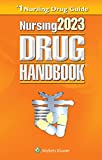
Pharmacology and the Nursing Process
The 10th edition of Pharmacology and the Nursing Process offers practical, user-friendly pharmacology information. The photo atlas contains over 100 unique illustrations and photographs depicting drug administration techniques. Updated drug content reflects the most recent FDA drug approvals, withdrawals, and therapeutic uses.
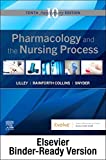
Mosby’s Pharmacology Memory NoteCards: Visual, Mnemonic, and Memory Aids for Nurses
The 6th edition of Mosby’s Pharmacology Memory NoteCards: Visual, Mnemonic, & Memory Aids for Nurses incorporates illustrations and humor to make studying easier and more enjoyable. This unique pharmacology review can be utilized as a spiral-bound notebook or as individual flashcards, making it ideal for mobile study.
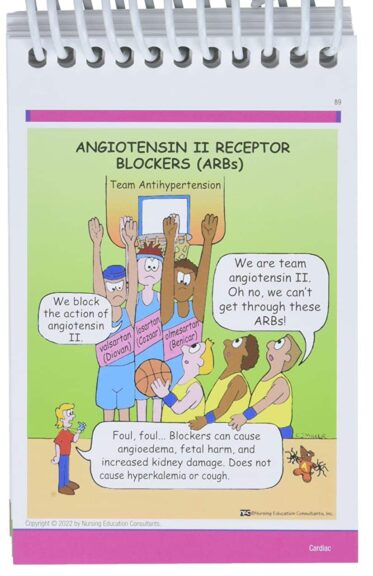
See Also
Here are other nursing pharmacology study guides:
- Nursing Pharmacology – Study Guide for Nurses
Our collection of topics related to nursing pharmacology - Pharmacology Nursing Mnemonics & Tips
These nursing mnemonics aim to simplify the concepts of pharmacology through the use of a simple, concise guide. - Generic Drug Name Stems Cheat Sheet
Learn about these generic drug name stems to help you make sense of drugs easier! - Common Drugs and Their Antidotes
A guide to drug antidotes that nurses should be familiar about. - IV Fluids and Solutions Guide & Cheat Sheet
Get to know the different types of intravenous solutions or IV fluids in this guide and cheat sheet. - Drug Dosage Calculations NCLEX Practice Questions (100+ Items)
Care to take the challenge? This quiz aims to help students and registered nurses alike grasp and master the concepts of medication calculation.
Drug Guides NEW!
Individual drug guides and nursing considerations for the most common medications used in nursing pharmacology:
- Acetaminophen (Tylenol)
- Aspirin
- Atorvastatin (Lipitor)
- Enoxaparin (Lovenox)
- Furosemide (Lasix)
- Gabapentin
- Hydromorphone (Dilaudid)
- Lisinopril
- Metoprolol
- Morphine
Gastrointestinal System Drugs
Respiratory System Drugs
- Antihistamines
- Bronchodilators and Antiasthmatics
- Decongestants
- Expectorants and Mucolytics
- Inhaled Steroids
- Lung Surfactants
Endocrine System Drugs
- Adrenocortical Agents
- Antidiabetic Agents
- Glucose-Elevating Agents
- Hypothalamic Agents
- Insulin
- Parathyroid Agents: Bisphosphonates, Calcitonins
- Pituitary Drugs
- Sulfonylureas
- Thyroid Agents
Autonomic Nervous System Drugs
- Adrenergic Agonists (Sympathomimetics)
- Adrenergic Antagonists (Sympatholytics)
- Anticholinergics (Parasympatholytics)
- Cholinergic Agonists (Parasympathomimetics)
Immune System Drugs
Chemotherapeutic Agents
- Anthelmintics
- Anti-Infective Drugs
- Antibiotics
- Antifungals
- Antineoplastic Agents
- Antiprotozoal Drugs
- Antiviral Drugs
Reproductive System Drugs
Nervous System Drugs
- Antidepressants
- Antiparkinsonism Drugs
- Antiseizure Drugs
- Anxiolytics and Hypnotic Drugs
- General and Local Anesthetics
- Muscle Relaxants
- Narcotics, Narcotic Agonists, and Antimigraine Agents
- Neuromuscular Junction Blocking Agents
- Psychotherapeutic Drugs
Cardiovascular System Drugs
References and Sources
The following are the recommended supplemental reading for this bronchodilator/antiasthmatic nursing pharmacology study guide:
- Adams, M. P., & Urban, C. (2015). Pharmacology: Connection to Nursing. Pearson Education.
- Karch, A. M., & Karch. (2008). Focus on nursing pharmacology. Lippincott Williams & Wilkins.
- Lehne, R. A., Moore, L. A., Crosby, L. J., & Hamilton, D. B. (2004). Pharmacology for nursing care.
- Smeltzer, S. C., & Bare, B. G. (1992). Brunner & Suddarth’s textbook of medical-surgical nursing. Philadelphia: JB Lippincott.

